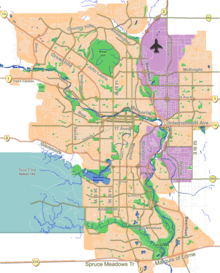Radisson Heights, Calgary
| Albert Park/Radisson Heights | |
|---|---|
| Neighbourhood | |

Downtown skyline view from Radisson Heights
|
|
| Location of Albert Park/Radisson Heights in Calgary | |
| Coordinates: 51°02′44″N 113°59′22″W / 51.04556°N 113.98944°WCoordinates: 51°02′44″N 113°59′22″W / 51.04556°N 113.98944°W | |
| Country |
|
| Province |
|
| City |
|
| Quadrant | SE |
| Ward | 10 |
| Established | 1910 |
| Government | |
| • Mayor | Naheed Nenshi |
| • Administrative body | Calgary City Council |
| • Councillor | Andre Chabot |
| Area | |
| • Total | 1.7 km2 (0.7 sq mi) |
| Elevation | 1,085 m (3,560 ft) |
| Population (2006) | |
| • Total | 6,098 |
| • Average Income | $38,019 |
| Website | Albert Park/Radisson Heights Community Association |
Albert Park/Radisson Heights is a residential neighbourhood in the south-east quadrant of Calgary, Alberta. It is bounded to the west by the Bow River and Deerfoot Trail, to the north by Memorial Drive and to the south by 17 Avenue SE. The community of Forest Lawn lies to the east.
This community, established in 1910, enjoys ample open space, is well provided with public and separate schools, has good access to shopping and city-wide transportation routes, and has views of the Bow River Valley, the Downtown and the Canadian Rockies.
However, like many communities in the inner city, it suffers from a number of problems such as shortcutting of nonlocal traffic, residential infill development that is insensitive to the block or the community at large. The community has an area redevelopment plan in place and is part of the International Avenue Business Revitalization Zone.
It is represented in the Calgary City Council by the Ward 10 councillor.
In the City of Calgary's 2012 municipal census, Albert Park/Radisson Heights had a population of 6,234 living in 2,709 dwellings, a 0.3% increase from its 2011 population of 6,217. With a land area of 2.5 km2 (0.97 sq mi), it had a population density of 2,490/km2 (6,460/sq mi) in 2012.
Residents in this community had an median household income of $38,019 in 2000. As of 2000, 25.9% of the residents were immigrants. A proportion of 40.2% of the buildings were condominiums or apartments, and 58% of the housing was used for renting.
...
Wikipedia

